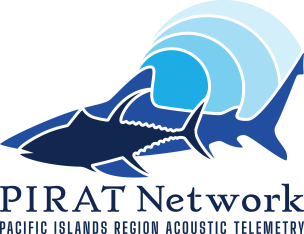FAQs
Who has access to the data that I submit to PIRAT?
Your detection data, tag metadata, receiver locations, etc. are ONLY immediately visible to those who are 1) members of your project, and 2) members of PIRAT. No one can just visit the PIRAT Network website and start perusing other peoples’ datasets at will (except the data managers, but we really need this access in order to get your data loaded.). When cross-over between projects occur (i.e. tags from one project detected on another project’s receivers), then there is some exchange of more specific information about tags and receivers, such as receiver coordinates and the species tagged. Various rules to prevent/discourage misuse, and encourage fair attribution of these data, are baked into the database structure and our User Agreement and Data Policy.
How do I join PIRAT?
- Fill out a Project metadata Form*.
- Send these to pirat@hawaii.edu and we will create a user account for you. This contains your own, private project repository folders.
- Start putting your tag and receiver metadata into Tagging Metadata and Receiver/Instrument Deployment metadata templates (also found HERE). Upload these along with your .VRLs (or .CSV detection exports) to your repository.
*If your project is part of an array that supports multiple projects, you MAY want to consider creating a separate Tag Project and Array Project. We recommend discussing this with the node manager to see what will work best for your needs. You can learn more about the difference between tag vs array projects HERE.
How do I upload my data to PIRAT?
At each of these data pushes, we will request updated data from our users – any new downloads, or new deployments of tags or receivers, should be submitted to the database. The data manager will QA/QC these data, load them into the database, and export updated detection records for each project.
What are the advantages of being a PIRAT?
Expanded study scope, easier data management, free cloud-based data archival, and the option to publish data to an global, open-access database.
Most probably don’t need a reminder, but in the days of yore (or last week for some people?), if you had some unknown tag IDs, you would embark on the altruistic quest of tracking down those tag owners via email or otherwise, and getting them their data. On the other side of things, you had to hope that other telemetry users would bother doing this (otherwise, how would you know your animals were detected anywhere else?). This was not terribly efficient, and a lot of potentially important detections could get lost in the cracks. Our goal here is to streamline this process, increase the overall efficiency of telemetry studies in the region, and make it easy to collaborate with your fellow telemetry users.
There is also the matter of maintaining good records of tag and receiver deployments across very long periods of time – this can be difficult, but the PIRAT database provides a framework for keeping track of these things. If you have obligations under a current grant to archive your data, this is a solution. Similarly, if you have obligations to eventually make your data public, there is a process available to publish your data to OBIS.
How (and how often) will I hear about whether my animals have been detected?
Three times per year, the database is updated in what we call “data pushes”. It usually takes a few weeks to process new data and check for cross-matches, but if your project has any new detections, you’ll get an email notification and be directed to some data exports. The detection exports will contain all detections from the detection data you’ve provided + any detections of your animals on other receivers. Also provided are contact info for PIs of the projects that have detected your animals, so you can communicate and reach an agreement about how the data will be used.

